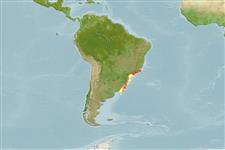Environment: milieu / climate zone / depth range / distribution range
Écologie
marin; profondeur 19 - 83 m (Ref. 47377). Subtropical; 22°S -
Southwest Atlantic: Rio de Janeiro (Ref. 26375) and Rio Grande do Sul (Ref. 47377), Brazil to the north of Argentina.
Taille / Poids / Âge
Maturity: Lm ? range ? - ? cm
Max length : 45.0 cm TL mâle / non sexé; (Ref. 26375); common length : 38.0 cm TL mâle / non sexé; (Ref. 47377)
Life cycle and mating behavior
Maturities | Reproduction | Spawnings | Egg(s) | Fecundities | Larves
Carvalho-Filho, A., 1992. Peixes: costa Brasileira. Marca D'Agua, Sao Paolo, Brazil. 304 p. (Ref. 26375)
Statut dans la liste rouge de l'IUCN (Ref. 130435)
Menace pour l'homme
Harmless
Utilisations par l'homme
Outils
Articles particuliers
Télécharger en XML
Sources Internet
Estimates based on models
Preferred temperature (Ref.
123201): 13.2 - 22.9, mean 19.5 °C (based on 42 cells).
Phylogenetic diversity index (Ref.
82804): PD
50 = 0.5000 [Uniqueness, from 0.5 = low to 2.0 = high].
Bayesian length-weight: a=0.00741 (0.00365 - 0.01506), b=2.93 (2.77 - 3.09), in cm total length, based on LWR estimates for this species & Genus-body shape (Ref.
93245).
Niveau trophique (Ref.
69278): 4.1 ±0.7 se; based on size and trophs of closest relatives
Résilience (Ref.
120179): Milieu, temps minimum de doublement de population : 1,4 à 4,4 années (Preliminary K or Fecundity.).
Fishing Vulnerability (Ref.
59153): Low to moderate vulnerability (35 of 100).
